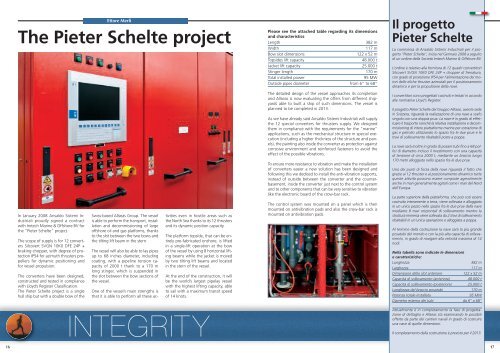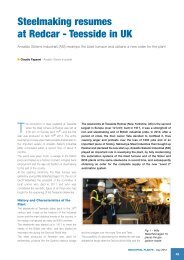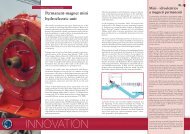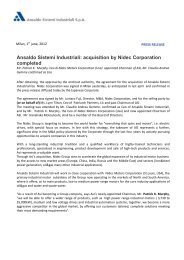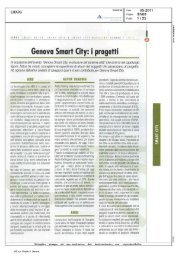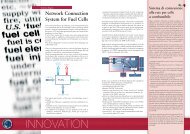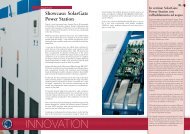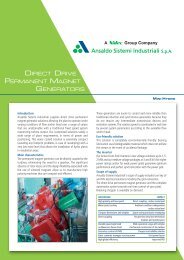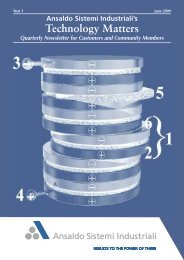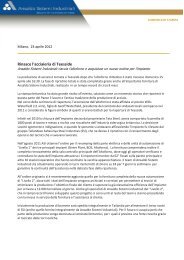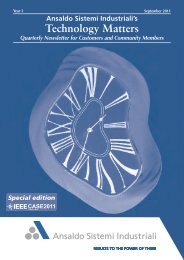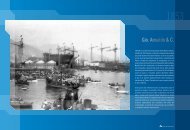Il progetto Pieter Schelte - Ansaldo Sistemi Industriali
Il progetto Pieter Schelte - Ansaldo Sistemi Industriali
Il progetto Pieter Schelte - Ansaldo Sistemi Industriali
You also want an ePaper? Increase the reach of your titles
YUMPU automatically turns print PDFs into web optimized ePapers that Google loves.
16<br />
The <strong>Pieter</strong> <strong>Schelte</strong> project<br />
In January 2008 <strong>Ansaldo</strong> <strong>Sistemi</strong> <strong>Industriali</strong><br />
proudly signed a contract<br />
with Imtech Marine & Offshore BV for<br />
the “<strong>Pieter</strong> <strong>Schelte</strong>” project.<br />
The scope of supply is for 12 converters<br />
Silcovert SVGN 10K0 DFE 24P +<br />
braking chopper, with degree of protection<br />
IP54 for azimuth thrusters propellers<br />
for dynamic positioning and<br />
for vessel propulsion.<br />
The converters have been designed,<br />
constructed and tested in compliance<br />
with Lloyd’s Register Classification.<br />
The <strong>Pieter</strong> <strong>Schelte</strong> project is a single<br />
hull ship but with a double bow of the<br />
Ettore Merli<br />
Swiss-based Allseas Group. The vessel<br />
is able to perform the transport, installation<br />
and decommissioning of large<br />
offshore oil and gas platforms, thanks<br />
to the slot between the two bows and<br />
the tilting lift beam in the stern.<br />
The vessel will also be able to lay pipes<br />
up to 68 inches diameter, including<br />
coating, with a pipeline tension capacity<br />
of 2000 t thank to a 170 m<br />
long stinger, which is suspended in<br />
the slot between the bow sections of<br />
the vessel.<br />
One of the vessel’s main strengths is<br />
that it is able to perform all these ac-<br />
tivities even in hostile areas such as<br />
the North Sea thanks to its 12 thrusters<br />
and its dynamic position capacity.<br />
The platform topside, that can be entirely<br />
pre-fabricated onshore, is lifted<br />
in a single-lift operation at the bow<br />
of the vessel by using 8 horizontal lifting<br />
beams while the jacket is moved<br />
by two tilting lift beams and located<br />
in the stern of the vessel.<br />
At the end of the construction, it will<br />
be the world’s largest pipelay vessel<br />
with the highest lifting capacity, able<br />
to sail with a maximum transit speed<br />
of 14 knots.<br />
INTEGRITY<br />
Please see the attached table regarding its dimensions<br />
and characteristics:<br />
Length 382 m<br />
Width 117 m<br />
Bow slot dimensions 122 x 52 m<br />
Topsides lift capacity 48.000 t<br />
Jacket lift capacity 25.000 t<br />
Stinger length 170 m<br />
Total installed power 95 MW<br />
Outside pipes diameter from 6" to 68"<br />
The detailed design of the vessel approaches its completion<br />
and Allseas is now evaluating the offers from different shipyards<br />
able to built a ship of such dimensions. The vessel is<br />
planned to be completed in 2013.<br />
As we have already said <strong>Ansaldo</strong> <strong>Sistemi</strong> <strong>Industriali</strong> will supply<br />
the 12 special converters for thrusters supply. We designed<br />
them in compliance with the requirements for the “marine”<br />
applications, such as the mechanical structure in special execution<br />
(including a higher thickness of the structure and panels),<br />
the painting also inside the converter as protection against<br />
corrosive environment and reinforced fasteners to avoid the<br />
effect of the possible vibrations.<br />
To ensure more resistance to vibration and make the installation<br />
of converters easier a new solution has been designed and<br />
following this we dediced to install the anti-vibration supports,<br />
instead of outside between the converter and the counterbasement,<br />
inside the converter just next to the control system<br />
and to other components that can be very sensitive to vibration<br />
like the electronic board of the crow-bar rack.<br />
The control system was mounted on a panel which is then<br />
mounted on antivibration pads and also the crow-bar rack is<br />
mounted on antivibration pads.<br />
<strong>Il</strong> <strong>progetto</strong><br />
<strong>Pieter</strong> <strong>Schelte</strong><br />
La commessa di <strong>Ansaldo</strong> <strong>Sistemi</strong> <strong>Industriali</strong> per il <strong>progetto</strong><br />
“<strong>Pieter</strong> <strong>Schelte</strong>”, inizia nel Gennaio 2008 a seguito<br />
di un ordine della Società Imtech Marine & Offshore BV.<br />
L’ordine è relativo alla fornitura di 12 quadri convertitori<br />
Silcovert SVGN 10K0 DFE 24P + chopper di frenatura,<br />
con grado di protezione IP54 per l’alimentazione dei motori<br />
delle eliche thruster azimutali per il posizionamento<br />
dinamico e per la propulsione della nave.<br />
I convertitori sono progettati costruiti e testati in accordo<br />
alle normative Lloyd’s Register.<br />
<strong>Il</strong> <strong>progetto</strong> <strong>Pieter</strong> <strong>Schelte</strong> del Gruppo Allseas, avente sede<br />
in Svizzera, riguarda la realizzazione di una nave a scafo<br />
singolo con una doppia prua. La nave è in grado di effettuare<br />
il trasporto nonché la relativa installazione e decommissioning<br />
di intere piattaforme marine per estrazione di<br />
gas e petrolio utilizzando lo spazio fra le due prue e le<br />
travi di sollevamento ribaltabili poste a poppa.<br />
La nave sarà inoltre in grado di posare tubi fino a 68 pollici<br />
di diametro incluso il rivestimento con una capacità<br />
di tensione di circa 2000 t, mediante un braccio lungo<br />
170 metri alloggiato nello spazio fra le due prue.<br />
Uno dei punti di forza della nave riguarda il fatto che<br />
grazie ai 12 thruster e al posizionamento dinamico tutte<br />
queste attività possono essere compiute agevolmente<br />
anche in mari generalmente agitati come i mari del Nord<br />
dell’Europa.<br />
La parte superiore della piattaforma, che può così essere<br />
costruita interamente a terra, viene sollevata e alloggiata<br />
in un unico pezzo nello spazio fra le due prue della nave<br />
mediante 8 travi orizzontali di sollevamento mentre la<br />
struttura immersa viene sollevata da 2 travi di sollevamento<br />
ribaltabili in un’unica operazione e alloggiata a poppa.<br />
Al termine della costruzione la nave sarà la più grande<br />
posatubi del mondo e con la più alta capacità di sollevamento,<br />
in grado di navigare alla velocità massima di 14<br />
nodi.<br />
Nella tabella sono indicate le dimensioni<br />
e caratteristiche:<br />
Lunghezza 382 m<br />
Larghezza 117 m<br />
Dimensione dello slot anteriore 122 x 52 m<br />
Capacità di sollevamento (anteriore) 48,000 t<br />
Capacità di sollevamento (posteriore) 25,000 t<br />
Lunghezza del braccio posatubi 170 m<br />
Potenza totale installata 95 MW<br />
Diametro esterno dei tubi da 6” a 68”<br />
Attualmente è in completamento la fase di progettazione<br />
di dettaglio e Allseas sta esaminando le possibili<br />
offerte da parte dei cantieri navali in grado di costruire<br />
una nave di quelle dimensioni.<br />
<strong>Il</strong> completamento della costruzione è previsto per il 2013.<br />
17
18<br />
Before its implementation, these solution<br />
have been qualified by means<br />
of specific vibration test, performed<br />
in accordance with Lloyd's Register<br />
regulations. The tests concerned the<br />
power module, the control system<br />
panel and crow-bar rack.<br />
In order to satisfy the EMC requirements<br />
in terms of compatibility and<br />
emissions we revised the position of<br />
components inside the auxiliary and<br />
control cabinet. The control cabinet has<br />
been segregated by rest of the converter<br />
with a special EMC gasket installed<br />
on the internal part of the door.<br />
Again specific EMC tests have been<br />
performed to qualify this solution before<br />
its implementation.<br />
In order to satisfy the most stringent<br />
IP54 requirements concerning the degree<br />
of protection and considering the<br />
maximum ambient temperature of 50<br />
°C degrees, we designed a special water-air<br />
heat exchanger certified according<br />
to Lloyd's Register Classification,<br />
able to remove the power losses generated<br />
inside the converter.<br />
The IP54 protection does not allow<br />
any opening to drive the heated air<br />
out of the converter, so the heat ex-<br />
Ettore Merli<br />
changer cools the heated air and puts<br />
it back into circulation by using forced<br />
air path inside the converter itself.<br />
In addition, to ensure an high life-cycle<br />
service of the components and to<br />
avoid the fan to work always at full<br />
speed, we decided to control its rota-<br />
tion depending on the need for heat<br />
exchange. A system of special sensor<br />
can detect any water leakage inside<br />
the heat exchanger and a special filter<br />
(mazing filter) prevents that the water<br />
gets in touch with the electric components<br />
in particular in the medium<br />
voltage sections.<br />
The main constraints for the heat exchanger<br />
were that it was compact and<br />
suitable to the position already identified<br />
for power modules.<br />
Furthermore it is designed to be used<br />
also for the industrial applications. In<br />
this case the structure is the same, but<br />
the installation of the internal components<br />
is easier since it is not necessary<br />
for the heat exchanger to meet<br />
specific requirements in terms of resistance<br />
to vibration.<br />
The delivery and return system of the<br />
main stainless steel pipes for the internal<br />
cooling circuit and its distribu-<br />
tion to the power modules and to<br />
other devices with flexible pipes and<br />
fast joints Parker, have been designed<br />
by using our experience for SVTN for<br />
marine applications. This solution has<br />
been applied in order to provide a<br />
standardization of applicative solutions<br />
even among different products and to<br />
reinforce our experience and knowledge<br />
in other projects.<br />
All the above technical solutions has<br />
been improved to be applied also to a<br />
converter with higher power like<br />
SVGN 12K0.<br />
Regarding the schedule of our project<br />
we have fully tested 5 converters that<br />
are waiting for the final inspection by<br />
the Customer.<br />
Then they will be packed and shipped<br />
to Netherlands where Allseas is storing<br />
all the electrical components waiting<br />
to deliver them to the yard.<br />
Other 3 converters will be tested during<br />
the first week of March.<br />
The complete delivery to the Customer<br />
of the all the 12 converters is<br />
scheduled by the end of April<br />
INTEGRITY<br />
Come già detto <strong>Ansaldo</strong> <strong>Sistemi</strong> <strong>Industriali</strong> fornisce i 12 quadri convertitori per alimentazione dei thrusters. La progettazione dei<br />
quadri è stata effettuata implementando tutti quei requisiti necessari per l’ambiente “marine” quali la carpenteria in esecuzione<br />
speciale con maggiore spessore della struttura e dei pannelli, la verniciatura anche all’interno come protezione rispetto all’ambiente<br />
corrosivo e il rinforzo dei fissaggi per tenere conto delle possibili vibrazioni trasmesse dalla struttura della nave.<br />
Per garantire la resistenza alle vibrazioni e rendere più semplice l’installazione dei quadri convertitori è stata elaborata una nuova<br />
soluzione in base alla quale si è deciso di montare i supporti antivibranti non all’esterno fra il quadro e il contro basamento, ma all’interno,<br />
in corrispondenza di quei componenti identificati come i più sensibili alle vibrazioni quali il sistema di controllo ed il rack<br />
crow-bar. <strong>Il</strong> sistema di controllo è montato su un pannello a sua volta montato su antivibranti e anche il rack crow-bar è montato<br />
su antivibranti.<br />
Tutte queste scelte tecniche sono state validate prima dell’implementazione mediante specifiche prove di vibrazione, effettuate secondo<br />
le normative Lloyd’s, che hanno interessato il modulo di potenza, il pannello del sistema di controllo ed il rack crow-bar.<br />
Per soddisfare il requisito in termini di compatibilità ed emissione EMC è stato rivisto il posizionamento dei componenti negli scomparti<br />
ausiliari e di controllo, quest’ultimo è stato segregato dal resto del quadro anche utilizzando una speciale guarnizione EMC<br />
installata all’interno della porta.<br />
Anche in questo caso sono state effettuate specifiche prove EMC per validare queste soluzioni prima dell’implementazione.<br />
Una parte molto impegnativa della progettazione è stata dedicata al soddisfacimento della richiesta del grado di protezione IP54,<br />
anche tenendo conto della possibile temperatura ambiente massima di 50 gradi centigradi.<br />
Per questo è stato necessario ideare uno speciale scambiatore acqua-aria, certificato secondo le normative Lloyd’s, in grado di rimuovere<br />
le perdite che si generano all’interno del quadro convertitore.<br />
Lo scambiatore raffredda l’aria e la rimette in circolo mediante un percorso forzato, dato che, in virtù del grado di protezione IP54,<br />
non esistono aperture da cui sia possibile espellere l’aria riscaldata.<br />
Per garantire un’elevata vita utile dei componenti e per evitare che il ventilatore giri sempre al massimo della velocità, si è deciso<br />
di controllarne la rotazione in funzione della necessità di scambio termico.<br />
Particolare attenzione è stata data alle possibili perdite di acqua all’interno dello scambiatore, infatti un sistema di sensori permette<br />
di rilevare ogni perdita e una speciale tecnologia di filtro a labirinto impedisce che, in caso di perdite, l’acqua venga proiettata sui<br />
componenti di potenza nella zona a media tensione.<br />
Per quanto riguarda lo scambiatore, i principali vincoli sono stati che fosse compatto come dimensioni e che si adattasse al posizionamento<br />
già identificato per i moduli di potenza.<br />
Infine, lo scambiatore è stato progettato per essere impiegato anche per il settore industriale, in questo caso nella stessa struttura<br />
vengono fissati i componenti in modo più semplice, in quanto lo scambiatore non deve soddisfare particolari richieste in termini di<br />
resistenza alle vibrazioni.<br />
In un’ottica di standardizzazione delle soluzioni applicative anche fra prodotti diversi, e per sfruttare al meglio le esperienze acquisite<br />
in altri progetti, il sistema di mandata e ritorno delle tubazioni in acciaio inox di raffreddamento per il circuito interno e la relativa<br />
distribuzione ai moduli di potenza e agli altri dispositivi con tubi flessibili e innesti rapidi Parker, è stata realizzata facendo riferimento<br />
a quanto già impiegato per il quadro SVTN per ambiente “marine”.<br />
È importante notare che tutte le scelte tecniche sono state fatte mantenendo la possibilità di applicarle anche alla taglia superiore<br />
del quadro SVGN, il 12K0.<br />
Per quanto riguarda la pianificazione del <strong>progetto</strong> al momento sono stati completamente testati 5 quadri convertitori che sono in<br />
attesa dell’ispezione finale da parte del Cliente. I quadri verranno quindi imballati e spediti in Olanda dove Allseas sta immagazzinando<br />
tutti i componenti elettrici in attesa di inviarli al cantiere. Altri 3 quadri convertitori verranno collaudati nella prima settimana<br />
di marzo. <strong>Il</strong> completamento della consegna dei 12 quadri al cliente è previsto entro la fine del mese di aprile.<br />
19


